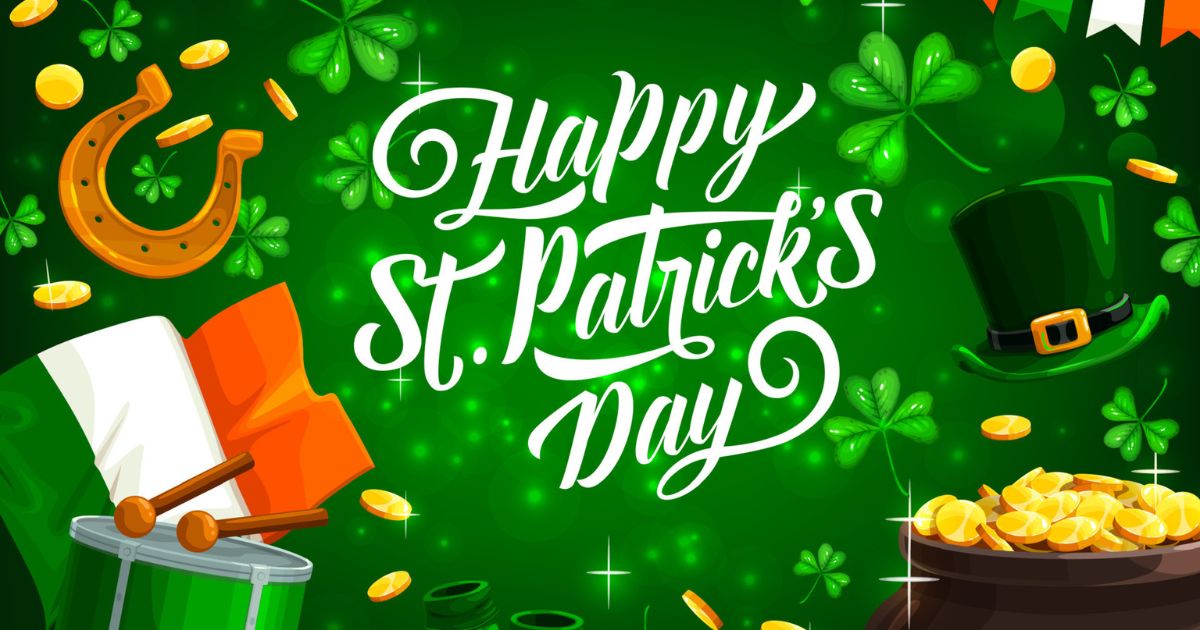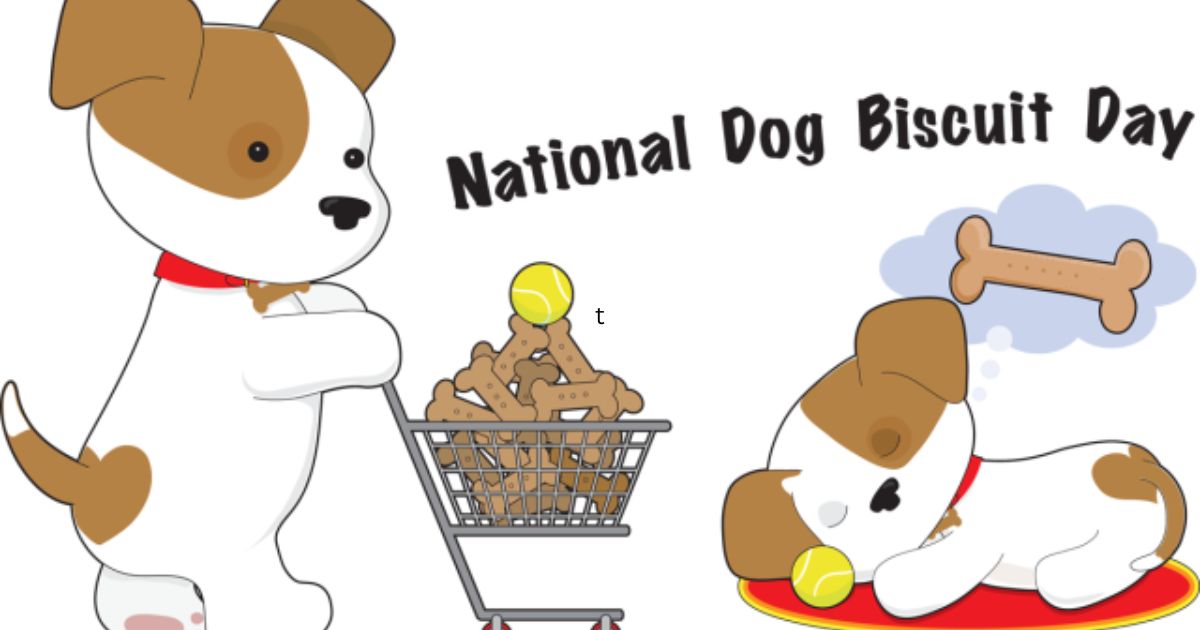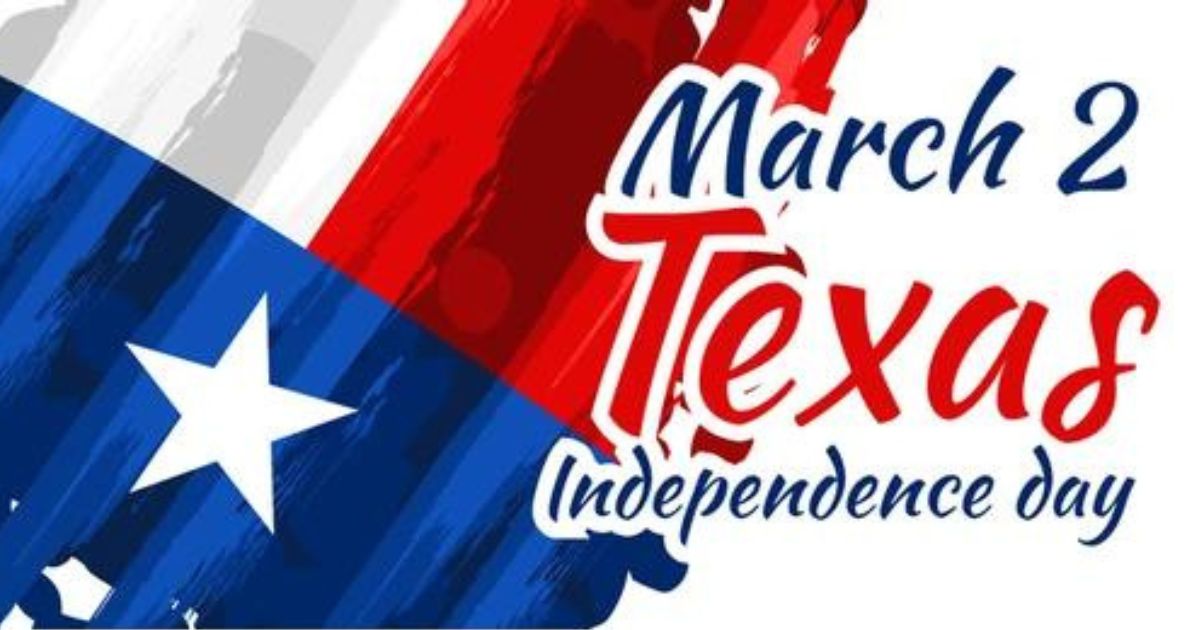Celebrating Happy St. Patrick’s Day with Irish Traditions
The Origins of St. Patrick’s Day
St. Patrick’s Day is an annual festival held on March 17th that celebrates Irish culture and heritage. It pays tribute to St. Patrick, the revered patron saint of Ireland who is credited with spreading Christianity across the island in the 5th century AD.
The festivities commemorate St. Patrick’s missionary work in converting the Irish to Christianity, allowing people of Irish descent to honor their ancestral roots and cultural traditions.
St. Patrick’s Day is a religious and cultural holiday that celebrates faith and national pride for the Irish people and their kin around the world.
Read More: Digital News Planet
Who Was St. Patrick?
St. Patrick was a 5th-century missionary and bishop credited with bringing Christianity to Ireland. As a young man of just 16 years old, Patrick’s life took an unfortunate turn when he was forcibly abducted from his homeland of Britain and transported to Ireland against his will to be enslaved there. Despite his British roots, the circumstances of his capture and forced relocation to the Emerald Isle as an adolescent slave set the stage for his future pivotal role in Irish history.
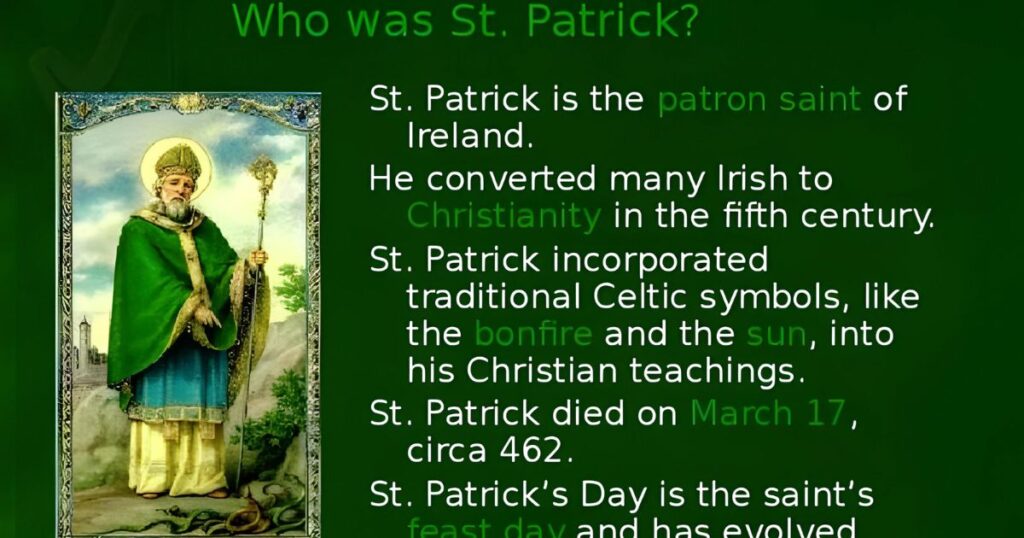
Later, he escaped and returned to his family. After becoming a priest, he returned to Ireland. He spent the remainder of his life converting the Irish people to Christianity.
When is St. Patrick’s Day
St. Patrick’s Day is annually celebrated on March 17th. This commemorates the death of St. Patrick, the foremost patron saint of Ireland.
Patrick’s Day 2024
In 2024, St. Patrick’s Day will be celebrated on Sunday, March 17th. Large parades, festivals, and events will likely take place worldwide on this date to honor Irish culture and heritage.
Traditions and Celebrations
Happy St. Patrick’s Day is celebrated worldwide, especially in Ireland and among Irish communities abroad. Here are some of the most popular traditions and celebrations:
Parades and Festivals
One of the most iconic St. Patrick’s Day traditions is the vibrant parades in cities worldwide. These parades feature marching bands, colorful floats, dancers, and people dressed in green, celebrating Irish culture and heritage.
Wearing Green
Wearing green attire is a widespread tradition on St. Patrick’s Day. It is said that wearing green makes you invisible to leprechauns, the famous Irish fairy creatures known for their mischievous ways.
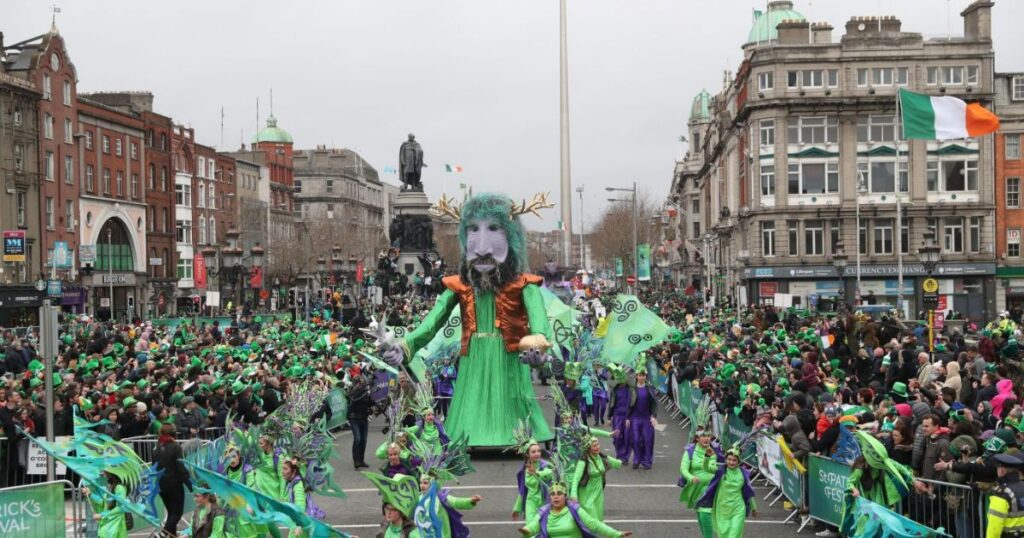
Irish Food and Drink
When St. Patrick’s Day arrives, celebrants delight in savoring iconic Irish culinary delights, such as the beloved combination of salted cured beef alongside boiled cabbage, the classic quick bread made with baking soda instead of yeast, and the hearty meat and vegetable stew topped with creamy mashed potatoes.
Pubs and bars like Guinness and Jameson also offer special menus featuring Irish beers and whiskeys.
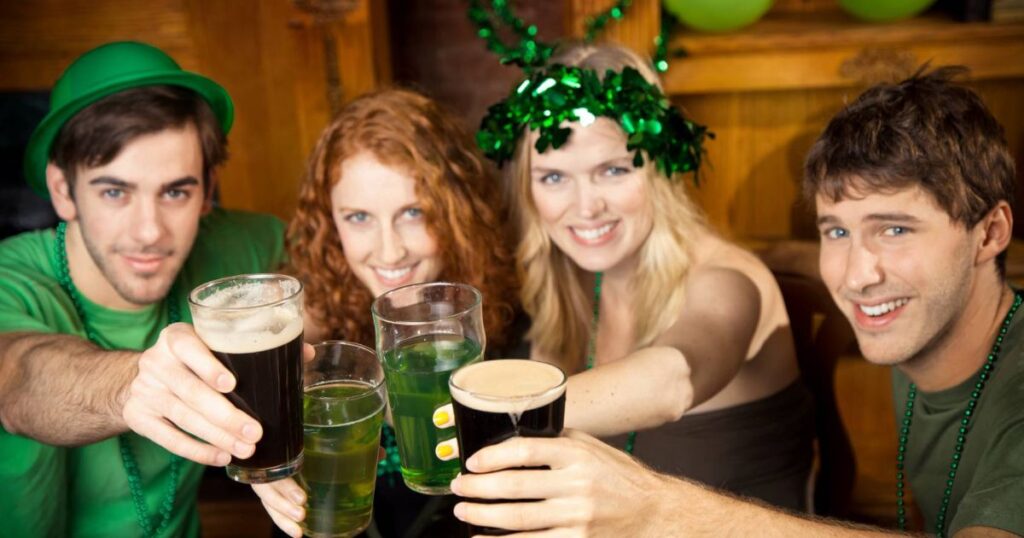
Patrick’s Day Parades Around the World
St. Patrick’s Day parades from New York City to Sydney, Australia, draw millions of spectators annually. Some of the largest and most renowned parades take place in:
- Dublin, Ireland
- New York City, USA
- Boston, USA
- Chicago, USA (where the river is dyed green)
- Montreal, Canada
Modern Celebrations and Trends
While Happy St. Patrick’s Day is rooted in Irish heritage, it has evolved into a global celebration of Irish culture and a day of festivity and fun for people of all backgrounds.
Green Beer and Themed Parties
Drinking green beer and hosting themed parties with Irish music, decorations, and costumes have become popular ways to celebrate St. Patrick’s Day, especially among younger generations.
Corporate Promotions and Merchandise
Many businesses and brands have capitalized on the popularity of St. Patrick’s Day by offering special promotions, themed merchandise, and green-colored products during March.
Environmental Initiatives
In recent years, some cities and organizations have embraced eco-friendly initiatives on St. Patrick’s Day, such as encouraging reusable cups and promoting sustainable practices during celebrations.
It presents a chance to gather with your loved ones in revelry, fostering an atmosphere brimming with delight and high spirits. Embrace the cultural significance while spreading cheer to all those around you. Sláinte!
Happy St. Patrick’s Day Wishes
Sending warm Happy St. Patrick’s Day wishes is a great way to spread joy and cheer with loved ones. Famous Irish blessings and sayings often used include:
- “On this St. Patrick’s Day, may good fortune find its way to you, with sunny skies and favorable winds guiding your path.”
- “May the gentle slopes of Ireland’s emerald hills bring you peace, and her beautiful waters refresh your spirit.”
- “As we celebrate St. Patrick’s feast day, may the legendary luck of the Irish surround you, and may you find yourself blessed with joy and prosperity.”
Happy St. Patrick’s Day Quotes
Inspirational quotes capture the spirit of St. Patrick’s Day:
- “For each petal on the shamrock this brings a wish your way – Good health, good luck, and happiness for today and every day.” – Irish Blessing
- “Never iron a four-leaf clover because you don’t want to press your luck.” – Irish Proverb
- “You’ve got to kiss the Blarney Stone to get the gift of the gab.” – Irish Saying
Happy St. Patrick’s Day Images Funny
Celebrating with humor is part of the fun! Popular funny memes and images poke fun at St. Patrick’s Day stereotypes like:
- Leprechauns
- Excessive green attire
- Over-indulging in Irish drinks

How is St. Patrick’s Day Celebrated
St. Patrick’s Day is celebrated through parades, parties, wearing green, Irish music/dancing, and traditional Irish food and drink. Some key celebrations include:
- The St. Patrick’s Day Parade in Dublin, Ireland
- Dyeing the Chicago River green
- New York City’s St. Patrick’s Day Parade
- Pub crawls and green beer specials.
St. Patrick Day Pictures
Iconic pictures symbolize the Irish pride of St. Patrick’s Day:
- The St. Patrick’s Saltire/Cross (red X on white background)
- Three shamrock leaves
- Leprechauns with green suits and red hair
- The Celtic harp and Irish dancers
Why Do We Celebrate St. Patrick’s Day in the United States
Though St. Patrick’s Day started as a Irish religious holiday, it’s widely celebrated in the United States due to:
- The large Irish-American population
- Irish soldier contributions to the Revolutionary War
- Promoting Irish culture and national pride
- Embracing the Saint as a symbol of faith
- Festivities surrounding Irish-American heritage
FAQs:
Q: What is the meaning of Happy St Patrick’s Day?
A: “Happy St. Patrick’s Day” is a standard greeting to wish someone well on the annual Irish cultural celebration of St. Patrick’s Day on March 17th. It conveys sentiments of good luck, joy, and Irish pride.
Q: How do you wish someone on St Patrick’s Day?
A: Popular ways to wish someone a happy St. Patrick’s Day include saying “Happy St. Patrick’s Day!” and “Top o’ the mornin’ to ya!” sending cards with Irish blessings like “May the road rise to meet you” or sharing Irish toasts like “Sláinte!” (meaning “Good health!”).
Q: Do people say, Happy St Patrick?
A: Yes, it’s common for people to say “Happy St. Patrick’s” as an abbreviated way of wishing someone a Happy St. Patrick’s Day.
Q: Why is St Patrick’s Day lucky?
A: St. Patrick’s Day is considered a lucky celebration because it is associated with lucky Irish symbols like shamrocks, leprechauns, pots of gold, and rainbows. The color green is also linked to good luck.
Q: What did Saint Patrick do?
A: St. Patrick was a 5th-century missionary who brought Christianity to Ireland. He used the shamrock’s three leaves to teach the Holy Trinity and converted many to Catholicism.
Q: What is the symbol for St. Patrick?
A: The most prominent symbol of St. Patrick is the shamrock, which he used as a metaphor to explain the Holy Trinity. Other symbols include the Celtic cross, leprechauns, and the Irish harp.
Q: Who celebrates St Patrick’s Day?
A: St. Patrick’s Day is celebrated by those of Irish descent and many people worldwide who enjoy the festivities regardless of ethnicity. It’s trendy in Ireland, the United States, Canada, Australia and the UK.
Q: What are the three symbols of St Patrick’s Day?
A: The three main symbols of St. Patrick’s Day are the shamrock, the leprechaun, and the color green.
Q: What is St. Patrick’s flower?
A: The shamrock is considered St. Patrick’s flower. He used its three leaves to symbolize the Holy Trinity when introducing Christianity to Ireland.
Q: What are three facts about St. Patrick’s Day?
A: 1) It commemorates St. Patrick’s arrival of Christianity in Ireland. 2) New York City hosts the largest St. Patrick’s Day parade. 3) The Chicago River is dyed green every year to celebrate.
Q: What color is lousy luck on St. Patrick’s Day?
A: The color orange is considered unlucky to wear on St. Patrick’s Day, as it represents the Protestant tradition rather than the Irish Catholic roots of the holiday.
Q: Why is St. Patrick’s Day red?
A: The original color associated with St. Patrick was blue. Over time, green became linked with Irish nationalism and the Catholic Saints. However, the St. Patrick’s Cross is red.
Q: Who is St. Patrick for kids?
A: For children, St. Patrick is often depicted as an older man with a kind face, wearing green robes and a miter hat. He is shown using a shamrock to illustrate the concept of the Holy Trinity.
Q: Is St. Patrick’s Day blue or green?
A: While the original color was blue, green has become the quintessential color of modern St. Patrick’s Day celebrations.
Q: Why was St. Patrick’s Day blue?
A: St. Patrick’s iconic blue color represented the historic secular holiday before the shift to green as Ireland’s symbolic Catholic color during the 19th-century Irish nationalism movement.

